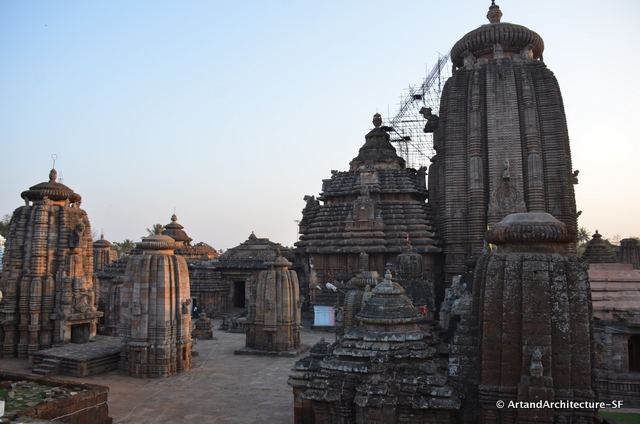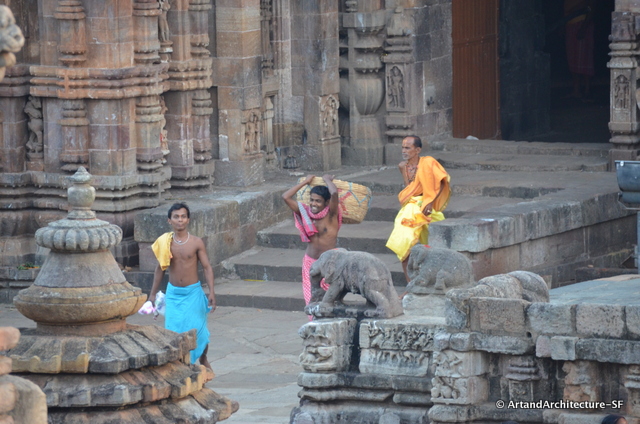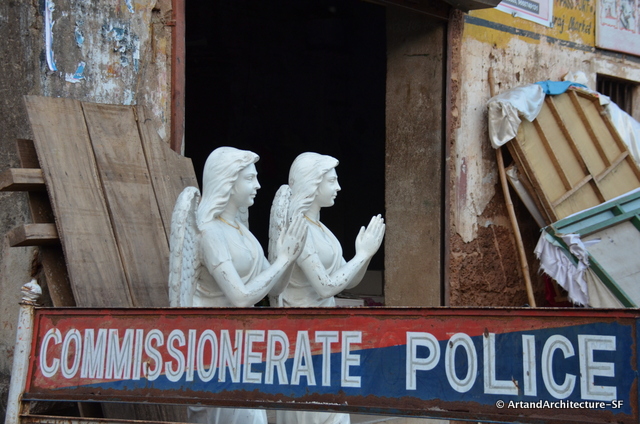February 2015
There are over 400 temples, only a fraction of what is thought to have once been 7000 temples, in Bhubaneswar and today we went exploring.
Our first stop was a pre-temple structure. The Udaigiri and Khandagiri caves were honeycombed with little retreats for Jain monks in the 1st century BC. The highway cuts through the two “hills” and we explored Udaigiri.
These are small rooms for the monks, when it was time for them to depart the world they would have their acolytes seal them in and they would then leave their bodies and this world.
The concept of, what in the west, would be termed suicide, is not, in any way, what the Jain’s practice. Theirs is one of the more scripted and strict religions regarding harming any life form; they simply believe that it is not important that their bodies are part of this worldly space. If you are interested in reading one of the most poignant articles on Jain spirituality I suggest you read William Dalrymple’s Nine Lives: In Search of the Sacred in Modern India.
Next stop the Tribal Museum
 The state of Orrisa has 62 culturally vibrant tribes and 13 Primitive Tribal Groups. These people constitute 22% of the states population (as of the 2001 census). Orissa is very aware of the fact that these tribal traditions are vital to their history and has several government agencies watching, documenting, educating and bringing nutrition to these remote areas and peoples. These groups fall under the Scheduled Castes and Scheduled Tribes Research and Training Institute (SCSTRTI)
The state of Orrisa has 62 culturally vibrant tribes and 13 Primitive Tribal Groups. These people constitute 22% of the states population (as of the 2001 census). Orissa is very aware of the fact that these tribal traditions are vital to their history and has several government agencies watching, documenting, educating and bringing nutrition to these remote areas and peoples. These groups fall under the Scheduled Castes and Scheduled Tribes Research and Training Institute (SCSTRTI)
 The museum is the focal point of this work, while it does not allow photos inside, it is a truly well laid out museum with a wonderful collection of tribal art.
The museum is the focal point of this work, while it does not allow photos inside, it is a truly well laid out museum with a wonderful collection of tribal art.
Now the temples… over centuries, under the patronage of different dynasties these temples have evolved and grown taller. There is no real understanding of the exact reason for the various types of architecture or ornamentation, but they are each unique in their own way. Most of the temples have two main components, a convex curvilinear spire (deul) which holds the inner sanctum, which is where the deity is kept, and then the assembly hall (jagamohan), which acts as an entryway.
Parsurameswar Temple (7th century AD), dedicated to Lord Shiva is the best-preserved specimen of early Hindu temples of this period. The experimentation in design can be seen in its ornate carvings. The jaghamon structure is one of the only surviving, substantially intact, jagamohans of this earlier period.

The roof of the Parsurameswwar jagamohan. It is possible that this is patterned after what would have originally been a wood structure, but it is not really known.
Mukteswar Temple is considered one of the jewels of Orissan temple architecture. The sculptures and ornamentation are just sumptuous.
Snakes are a big part of worship and play a prominent role in the temples here in Orissa. According to Varaha Purana, Lord Brahma’s son Kashyapa had four wives. Kashyapa’s first wife gave birth to Devas, second to Garudas, third to Nagas (snakes) and fourth to Daityas (demons). Enough said.. the Hindu religion is filled with gods and would take a dissertation to explain.
The Rajarani sits out in a lovely middle class neighborhood. This temple, renowned for its magnificent sculptures, is such a peaceful place.
This copulating couple sits at the point where one of the many sided walls comes together. It is not really known why but it is interesting to speculate that the joining of the couple and the joining of the walls are symbolic.
Our last stop was the Lingaraj Temple. The temple is off limits to non-Hindus, however they have erected a tower outside the walls to peer in. This temple complex represents the high point of the Orissan style where both sculpture and architecture have found harmony.
It is enshrined within a compound wall of laterite measuring 520 feet by 465 feet. The wall is 7.5 feet thick and surmounted by a plain slant coping. Alongside the inner face of the boundary wall, there is a terrace to protect the compound wall against “outside aggression”. The tower is 180 feet high and the complex has 150 smaller shrines in its courtyard. Each inch of the 180 foot tall tower is sculpted. The tower is not scaffolded, that is a ladder for the monks to light a fire on the top during a recent festival.
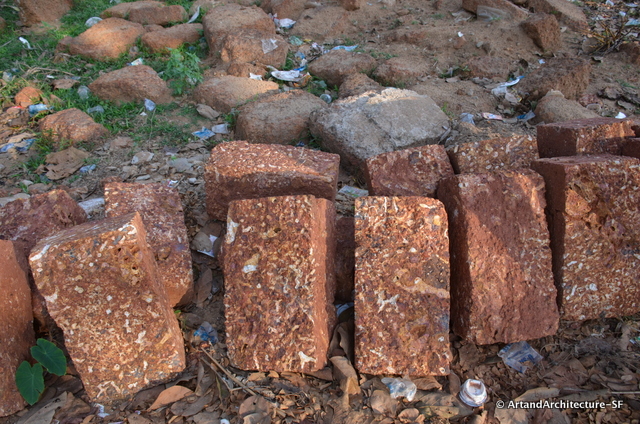
Laterites are soil types rich in iron and aluminium, formed in hot and wet tropical areas. Nearly all laterites are rusty-red because of iron oxides. They develop by intensive and long-lasting weathering of the underlying parent rock.
The temple is built in the Deula style that has four components namely, vimana (structure containing the sanctum), jagamohana (assembly hall), natamandira (festival hall) and bhoga-mandapa (hall of offerings). It has a dance hall that was associated with the raising prominence of the devadasi system of the past. A Devadasi is a girl dedicated to worship and service of a deity or a temple for the rest of her life. These woman were temple dancers, and revered within their society.
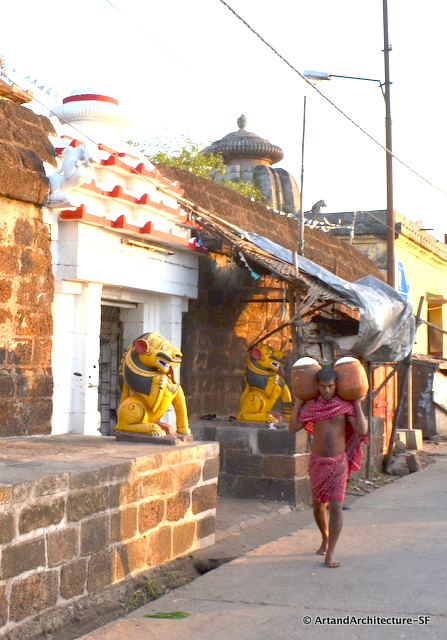
The kitchen at Langarj is the largest in the world and serves over 100,000 people per day.
Walking to the Lingaraj Temple one passes the Bindusagar Tank. This man-made lake has a pavilion in the middle and is believed to contain water from every sacred river in India. The main deity of the Lingaraj Temple is brought to this pavilion and lake each year for a ritual bath during Ashokashtami (in March and April). Keep in mind that during the monsoons this tank fills with fresh rain water and is far cleaner.
 These funny little figures are seen everywhere.
These funny little figures are seen everywhere.
Jagannath (or Jagannatha) meaning “Lord of the Universe”, or Vishnu, is the Black one. Balabhadra or Balarama is the older brother of Vishnu and is the white one. Sudarshana, the yellow one, is his only sister.
A little more about Bhubaneswar: Bhubaneswar replaced Cuttack as the capital in 1948, the year after India gained its independence from Britain. The modern city was designed by the German architect Otto Königsberger in 1946. Along with Jamshedpur and Chandigarh, it was one of modern India’s first planned cities. Bhubaneswar has decided to make tourism its major source of income and attracted about 1.5 million tourists in 2011. Their new governor has been responsible for placing tribal paintings on most walls you see in the city, making it a very art forward city.













